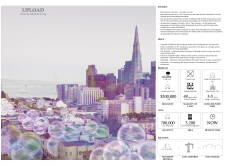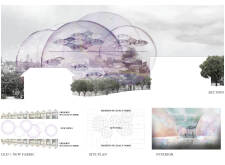5 key facts about this project
The project "Upload – Elevating Affordable Living" addresses the pressing issue of affordable housing in San Francisco, California. This architectural design focuses on providing a solution to the growing demand for cost-effective living spaces within a fluctuating urban landscape. The proposal seeks to integrate new housing types that promote community while respecting the historical architectural context of the city.
The design emphasizes modularity and flexibility, allowing for varying unit sizes that cater to diverse demographics, from single occupants to larger families. By addressing spatial efficiency and community needs, the project aims to create a vibrant residential environment.
Innovative Design Approaches
One of the distinguishing features of this project is its use of inflatable structures. This material choice considers both affordability and ease of assembly, enabling rapid deployment in response to housing shortages. The integration of reinforced fabric membranes contributes to creating flexible interiors that maintain structural integrity while allowing light and visibility.
Additionally, the project incorporates communal spaces that encourage interaction among residents. These areas are strategically placed to foster a sense of community, which is vital in urban settings where individual living spaces can often feel isolated. The layout promotes social engagement without compromising individual privacy, a balance that is frequently challenging to achieve in residential design.
Sustainable Materiality and Legacy Context
The project adeptly combines sustainable building materials with traditional design elements, maintaining a respectful dialogue with the historical fabric of San Francisco. By invoking concepts of duality, the design contrasts modern materials with classic architectural forms, ensuring that new structures are cohesive with their surroundings yet distinctly modern.
This approach allows for the coexistence of old and new, creating a layering of experiences for residents and visitors alike. The focus on lightweight, adaptable materials not only responds to immediate housing needs but also addresses long-term sustainability concerns, positioning the project as a forward-thinking solution within urban development.
For a comprehensive understanding of the various architectural elements, including architectural plans, sections, and design ideas, readers are encouraged to explore the project's presentation in detail. This exploration will provide deeper insights into how the design effectively combines functionality, community interaction, and a respectful acknowledgment of historical context.





















































